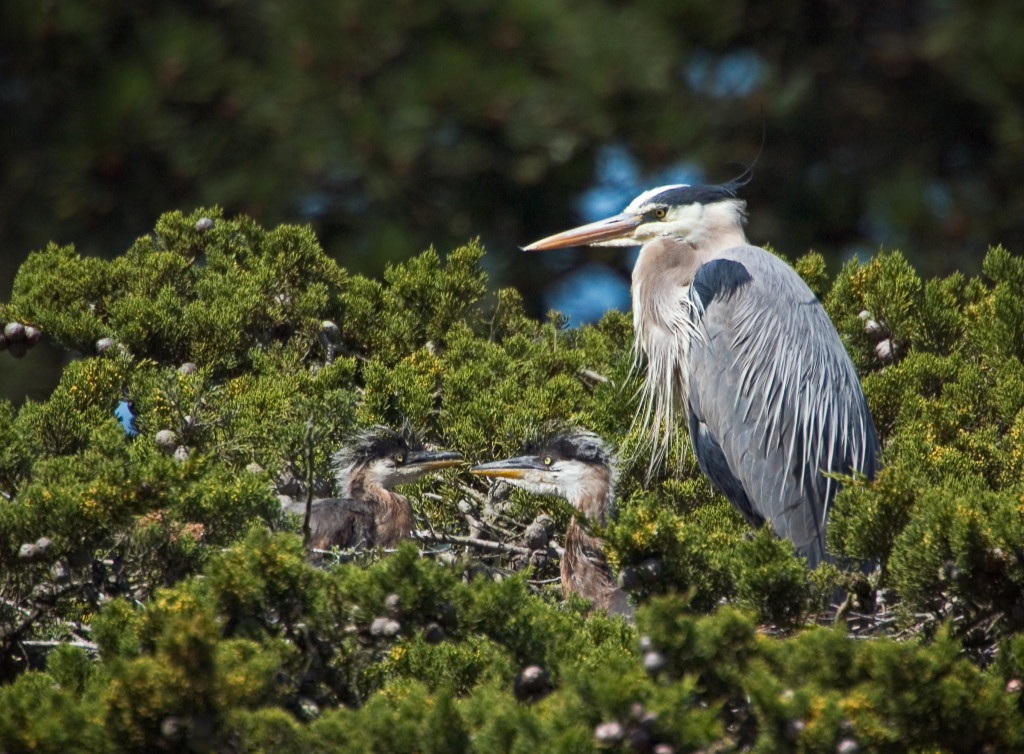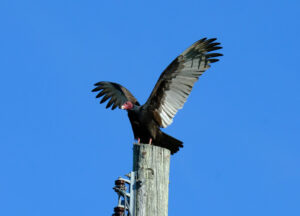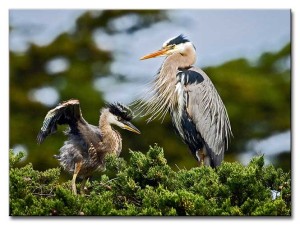A sign placed outside the Stow Lake Boathouse informs visitors of the variety of bird species that use the lake, such as the pied-billed grebe, Canadian goose, downy woodpecker and Allen’s hummingbird.
Yet although about 40 bird species live in Golden Gate Park, there is one that is the main attraction for Stow Lake: the great blue heron.
“Great Blue Herons are probably the most charismatic bird in America – people love them,” says Nancy DeStefanis, executive director of San Francisco Nature Education and a woman dedicated to Stow Lake’s local herons.
Nancy hands me a set of postcards with colorful photographs. She points to one showing a heron chick with a black Mohawk spreading its small and not-completely-feathered wings, and says with a smile, “See this is why I do this. Who couldn’t love these guys? I’m a sucker for them.”
Nancy has worked for 10 years to install a camera at Stow Lake so people can enjoy the birds from home and see the chicks as they grow.
“It takes money, will, and collaboration,” she says, and she is careful to mention the list of acknowledgements on the SF Nature Education website.

Today, that hard work and collaboration is paying off, because the first official SF Nature Education Heron Cam is finally installed, and it represents the first camera on a heron colony in all of California.
The camera will act as a tool to help educate the public about the herons, especially children. On their website, SF Nature Education will provide activities targeted to 3rd to 5th grade teachers so children can learn about the heron’s biology and life-cycle, as well as the history of the colony. Nancy will also use recordings of the video to continue her 21-year monitoring and research of the colony.
Nancy first discovered herons nesting at Stow Lake in 1993.
“I was totally knocked out – to see a humongous bird fly in and two other humongous birds stand up,” she recalls.
Previously a community organizer and lawyer who often worked pro-bono cases for social justice causes, these nests were the beginning of a new phase in Nancy’s life.
Through SF Nature Education, she has led the popular and free Heron Watch program for the last 12 years. Both adults and children can look through scopes to see the herons up close and learn from volunteer naturalists about bird behavior. Children also get field journals to color in the 40 different bird species found at the Park.
Stow Lake sits near the center of Golden Gate Park. In the center of Stow Lake sits Strawberry Island — so big the lake almost seems like a river around it. Yet, a much smaller island finds space between the shore and Strawberry – “Heron Island,” as Nancy calls it.
Atop the tall Monterey cypresses on Heron Island, above all the other birds and high above the crowds, Nancy shows me a great blue heron sitting in a nest made of sticks about 5 feet wide. This bird is one of their veteran male herons – his tongue protrudes through his neck and this injury makes him recognizable. This is his fifth confirmed nesting year here. She tells me he has been sitting like that for days, indicating the nest is likely full of chicks.

This year there are three heron nests, all in the same tree. Nancy thinks there may even be another “secret nest” in the back. According to Nancy, chicks should be visible very soon. She is hoping for the same numbers as last year: six, with two per nest. Around mid-May the chicks should start branch-hopping and taking their first flights. Once they start experimenting with flight, they’ll stay around the nest for about another two weeks before heading away from the colony. Nancy says they probably move to other parks in the Bay Area once they leave Stow Lake.
Based on the angle of light, the best time to see the nests through the heron cam will be anywhere from dawn until about 1pm, although it will be on all day. The video can be accessed at SF Nature Education’s website.
With public access postponed to the heronry at the Martin Griffin Preserve of Audubon Canyon Ranch, due to the colony failure last year, Stow Lake may be the best option for viewing herons in the Bay Area this nesting season.
While we talk, Nancy checks her email. “I think we’re on right now,” she says. We check a computer and see that the camera is live. She is thrilled.
“I’m so excited, I can’t tell you.” She lets out a happy laugh, “I’m such a happy camper. I’m going to remember this day.”
If You Go:
Heron Watch is free and will take place from 10:00 am to 1:00 pm on Saturdays from April 12 – May 17. Signs will be posted at the Stow Lake Boathouse to the observation site, where volunteers will show adult herons and chicks through scopes and talk about heron behavior. Bring binoculars and water; if you don’t have binoculars, you can borrow some from Heron Watch. Visitors will receive a checklist of the birds and children receive field journals and heron mobiles.
Volunteer-led Nature Tours to see the herons and other birds around Stow Lake and Strawberry Island are also available for $10 for
adults (children are free). Meet at same observation site from 10:30 am to noon on the same days as Heron Watch.
Autumn Sartain is a Bay Nature editorial intern.




-300x235.jpg)